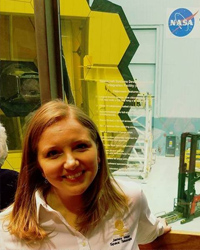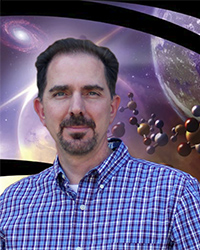The UCF AVS student chapter is organizing an online, virtual Webinar series on topics in theoretical and
experimental astrochemistry, an exciting and highly interdisciplinary field.
These webinars are intended to be for an audience with a broad range of expertise, so whether you are already working in astrochemistry as a professional or graduate student,
or you are just beginning your research career and are curious about these topics, please join us!
To register for the webinar, please fill out this Google form.
If you register, you will receive weekly email updates about the webinars as well as Zoom/WebEx links to attend them.
If you are interested in contributing a talk to the series, please email AVSknights@gmail.com.

Carbonaceous chondrites (carbon-rich meteorites) represent some the oldest and most primitive pieces of material formed in the Solar System; indeed, they could even be older than the Sun itself. These carbon-rich meteorites may have delivered an important concentration of organic compounds and water to the primitive Earth. Multiple organic classes, including those required for life (e.g. amino acids, carboxylic acids, nucleobases and polyols) have been identified from carbonaceous chondrites, providing valuable insights into the chemical inventory of the early Solar System, the primordial synthesis of organic matter, and the question of how life appeared on Earth.
Amino acids constitute the basic building blocks of all protein-based living organisms on Earth and thus, they are among the most intriguing and studied meteoritic organic compounds found. Homochirality (predominance of the L enantiomer) in terrestrial biological proteins is a fundamental feature of life as we know it. L-enantiomeric excesses have been observed in some meteoritic amino acids, raising interesting questions about a potential link between meteorites and terrestrial homochirality. In addition, the stable isotopic compositions (D, 13C, 15N) of meteoritic organic compounds provide information on their formation mechanisms and histories. Contrasting the distribution, chirality and isotopic composition of meteoritic organic compounds in a wide range of carbonaceous chondrites provide important insights on the composition and environments of the protosolar nebula, the meteorite parent bodies, and may well provide clues about their synthesis and survival during the formation of our Solar System.
I will present results from our extensive investigation on the abundance and molecular distribution of amino acids, and other biologically relevant molecules extracted from meteorites. We will discuss their potential prebiotic origins and relevance to the emergence of life on Earth.

The chemistry of the Earth is tied to only a small set of conditions while most of the rest of the Universe is often grossly different from terrestrial circumstances. Consequently, astrochemical experiments can be quite difficult to perform, but quantum chemistry does not suffer the same difficulties. Here, quantum chemistry is applied to the prediction of gas-phase spectroscopy and molecular formation of various “unstable” molecular systems. The spectra of seemingly strange species including proton-bound complexes (i.e. OC—H+—CO), noble gas molecules (i.e. ArCH2+, NeON+, & ArOH+), premineral molecules (i.e. Mg2O2 & MgSiO3), anions (i.e. Ph-C2-), and odd bonding in chalcogen hydrides (H2S—S+) have been produced and even linked with laboratory and astrophysical detections. The applications of these findings stretch from the esoteric of fascinating and novel chemistry to indicators of early stages of planet formation even to abiotic molecular oxygen synthesis in comets, atmospheres, and the early Earth.

The composition and structure of dust and ice grains in the interstellar medium, protoplanetary nebulae, and on the surfaces of airless bodies (such as moons and asteroids) are modified by ionizing radiation from a wide variety of sources. Describing how radiation affects the structure of grains and volatile molecules, and how radiation effects differ according to energy and incident radiation type (ion, electron or photon), is critical to understanding both the formation and evolution of solar systems and the various environments present in our Solar System today.
In this talk, I will present several combined computational and experimental studies of ionizing radiation interactions with airless bodies. Similarities and differences between various radiation types and target compositions will be discussed, and it will be shown that laboratory methods can be used to explain many observed phenomena as well as predict various environmental conditions. Finally, the application of these results to processes occurring in the early Solar System, and to the evaluation of potential materials resources present on asteroids, will be explored.

Material in the interstellar medium is subjected to bombardment by several types of ionizing radiation including cosmic rays, stellar winds, x-rays, and gamma-rays. It is known that such radiation can have a significant physicochemical impact on interstellar environments, and a large body of experimental work has shown that the interaction between such energetic particles and low-temperatures ices can result in the formation of complex - even prebiotic - molecules. Even so, modeling the chemical effects of cosmic ray collisions with interstellar dust grain ice mantles has proven challenging due to the complexity and variety of the underlying physical processes. In this talk, recent work on this subject by us is reviewed and the possible applications to better understanding the chemistry of interstellar space is highlighted.

Near the beginning of solar-type star formation, a molecular cloud filled with dust and gas is formed. As the molecular hydrogen density rises past ~103 cm-3 , external UV photons are increasingly blocked from entering the cloud and gas-phase temperatures drop to ~10 K. Under such conditions, atoms readily accrete onto cold dust grains to form molecules, as the sticking coefficient of almost all atoms and molecules on these grains is unity. Without any external source of heat or ‘energetic’ particles driving the chemistry, this type of ice chemistry in molecular clouds is noted as ‘dark’ or ‘non-energetic’, and is dominated by radical-induced processes. In this talk, I will overview recent experimental laboratory results, supported by quantum chemical calculations, on the solid-state formation of simple and complex organic molecules (COMs) that can be formed by ‘dark’ ice chemistry. Particularly COMs will be highlighted, as the formation of only simple molecules by ‘dark’ ice chemistry has been largely realized. All experiments presented here are performed in the ultrahigh vacuum setup, SURFace REaction SImulation Device 3 (SURFRESIDE 3 ), which is designed to study solid-state ‘dark’ ice chemistry. Astronomical observations of ices are also presented, and are strongly linked to the experimental efforts. The presented formation pathways and abundances of a variety of simple molecules and COMs under astrochemically relevant conditions can be incorporated into astrochemical models, which can then be used to aid in future observational surveys with facilities such as the James Webb Space Telescope (JWST) and the Atacama Large Millimeter/submillimeter Array (ALMA).

With new detector/spectrometer technology, observing facilities, and the ESA/Rosetta mission, we are discovering the molecular complexity that exists within cometary comae and starting to gain further understanding into how these species may be preserved from the interstellar medium (ISM), formed within the nucleus, and/or during radiation processing and sublimation. The Rosetta mission to comet 67P/Churyumov–Gerasimenko demonstrated the large molecular inventory of species that are not quite detectable from ground-based facilities and/or we have yet had an opportunity to search for them with the sensitivity necessary for detection. However, other ground-based observatories, such as ALMA, have shown that some simple species are formed within the coma and likely derive from more complex parent species (not identified to date). It has been shown that ices provide a catalytic surface for complex organic molecule formation on interstellar dust grains and/or in cometary ices. When the ice is warmed (e.g. during star formation or when a comet approaches a star) many species desorb into the gas phase, but the relationship between ice and gas compositions is hardly understood. A new experimental technique for identifying species that desorb from interstellar/cometary ice analogs via millimeter/submillimeter spectroscopy has been developed to understand the connection between ice and gas compositions detected in comets and the ISM. This spectroscopic approach provides several benefits for laboratory ice studies including laboratory spectra that are directly comparable to observational spectra, structure-specific identification of complex mixtures containing species of the same mass, and measurement of rotational temperature and column density of the desorbed species. The benefits of combining IR spectroscopy, mass spectrometry, and mm/submm spectroscopy to identify photoproducts will be discussed; and new results for UV photolyzed methanol ices at low temperature (~10 K) will be presented.

The vital role played by the dust particles in the chemical complexity of the InterStellar Medium (ISM) is well-known through the combination of space/ground based observations and laboratory experiments. By simulating the cold icy grains of the ISM in the laboratory we can understand the physico-chemical nature of the dust particles. However, due to the wide range of molecules ranging from simple to complex, open to cyclic, and aliphatic to aromatic molecules that are known to be present in the ISM, the dust particles that are synthesized by the energetic processing of such molecules may be altogether different.
To-date, the dust particles from laboratory experiments mimicking interstellar conditions are known to be either aggregates of nano-grains or thin films. Nevertheless, our understanding on the dust particles that are synthesized from simple / complex molecules are limited.

Most of the materials in the universe are so distant or inaccessible that the only way we can study them is remotely using various types of telescopes. However, in some cases we can study these materials directly because the samples become physically available to us. Some samples come to us of their own accord in the form of meteorites and cosmic dust. In other cases we have to work hard to carry out sample return missions like Apollo, Stardust, OSIRIS-REx, Hayabusa, and Hayabusa2 in order to get the samples ourselves. Once samples are physically available in terrestrial laboratories, we can learn details about their compositions and histories that could never be established by remote observations. This talk will highlight some of the unique scientific advances that can be made through the study of extraterrestrial materials, and will describe the various ways in which samples become available for study, with a focus on the acquisition of samples by sample return spacecraft missions. Aspects of NASA’s Stardust comet sample return mission and JAXA’s Hayabusa asteroid sample return mission will be highlighted and scientific highlights of these missions will be discussed. Finally, the presentation will end with an overview of the current status of NASA’s OSIRIS-REx mission, which will is currently at Asteroid (101955) Bennu and will be returning samples to Earth in 2023.

Laboratory astrochemistry experiments have shown that complex organic molecules can form under astrophysical conditions from ice mixtures containing simple species such as H2O, CO, CO2, CH3OH, NH3, etc., when they are subjected to ionizing radiation (UV photons, energetic particles) at low temperatures (< 80 K). Organics formed in these experiments include compounds of great interest for astrochemistry and astrobiology such as amino acids, nucleobases, and sugar derivatives. Although most of these organic compounds have not been conclusively observed in astrophysical environments, they have been detected in carbonaceous meteorites. This strongly indicates that molecules of astrobiological significance and their precursors formed under extraterrestrial, non-biological conditions, in the dense molecular cloud from which our Solar System was born, and/or in the protosolar nebula during its formation. The presence of organic materials of biological importance in cold Solar System bodies, such as asteroids and comets, suggests that these compounds played a significant role in the origin of life on Earth. After a general overview of the field of laboratory astrochemistry, I will discuss the formation of organic species under astrophysically relevant conditions, from the UV irradiation of ice mixtures at low temperature. In particular, I will focus on the formation of organics of astrobiological interest such as amino acids, nucleobases, and sugar derivatives.

Since their discovery in the 1970’s, astronomers, astrophysicists and astrochemists have been intrigued by the nearly ubiquitous unidentified infrared emission (UIR) bands. In the 1980’s, investigators determined the most probably source of these emissions was a family of organic molecules known as Polycyclic Aromatic Hydrocarbons or simply PAHs. In order to better understand these interstellar IR features and utilize them as chemical probes of the cosmos, laboratory spectroscopists have spent the last three decades investigating the spectroscopy of PAHs under astrophysically relevant conditions. Similarly, PAHs are present throughout the Solar System, in comets, meteorites and interplanetary dust particles. However, there is a disparity in the sizes and structures of Solar System PAHs compared to the interstellar PAHs. This disparity sets up the question “Did interstellar PAHs survive the harsh radiation conditions of the proto-solar nebula and become the chemical feedstock for the organics found throughout the Solar System?” Given the presence of PAH-based molecules in our own biochemistry, the answer may influence the origins of life itself. This lecture will provide a historical background on the spectroscopic properties of PAHs, their use as probes of the cosmos, and discuss recent high energy experiments aimed at discovering the connection between interstellar PAHs and Solar System organics. The presentation will conclude with a discussion on the future research areas and directions in this field.

Nucleobases are important building blocks of RNA and DNA for all known organisms and determining their abiotic origins may be important to understanding the emergence of life. It has been hypothesized that many of the building blocks of life may have extraterrestrial origins that could be traced back to low temperature radiolysis and photolysis of interstellar ices. Here, we will discuss the use of laboratory experiments to study the formation of all of the five primary nucleobases (cytosine, uracil, thymine, adenine, and guanine) through the UV photolysis of ices containing pyrimidine and purine. We will also discuss the formation of nitrogen- and oxygen-aromatic heterocycles from the irradiation of aromatic hydrocarbons in ices. Finally, determining the radiolytic stability of nucleobases is also important for understanding the range of icy environments in which nucleobases from both abiotic and biogenic sources may persist. To that end, we will address the radiation stability of thymine and thymine mixed with water ice over a range of temperatures and concentrations.

Titan, Saturn’s largest moon, is the only solid body in the outer solar system with a dense atmosphere. Because Titan’s atmosphere is mostly composed of nitrogen and methane, it is often considered as a cold primordial Earth analog. In Titan’s atmosphere, a complex chemistry occurs between N2 and CH4, its main constituents, at temperatures lower than 200K, and leads to the production of heavy molecules and subsequently solid aerosols that form the orange haze surrounding Titan. I will present how three different experimental setups at NASA Ames are used to 1) simulate, at low temperature, Titan’s complex atmospheric chemistry and the formation of aerosols in its upper atmosphere (the Titan Haze Simulation experiment on COSmIC), 2) study the formation of benzene cloud in the stratosphere (the Atmospheric Chemistry Laboratory), and 3) determine the optical constants of Titan aerosol analogs (the NASA Ames Optical Constant facility).

Large PAH molecules are abundant in the interstellar medium of galaxies, locking up some 5% of
the elemental carbon. These PAHs are thought to be formed in the stellar ejecta of asymptotic
giant branch stars in processes akin to those in sooting flames. These molecules are heavily
processed by UV radiation and shocks in the interstellar medium during their sojourn from their
birth sites to protoplanetary disks where they eventually are incorporated into newly formed
planetesimals and cometesimals. Carbonaceous chondrites are among the most ancient
materials in the solar system and they retain almost the 5% of organic matter evolved in the early
solar system. Their carbon inventory provides a record of the organic material available in the
terrestrial formation zone of the solar system and the processes that played a role in their
formation and evolution. However, little is known about how they were delivered from the
interstellar medium to solar system objects as meteorites.
In this study, we use periodic density functional theory employing the vdW-DF functional, to
model four different {010} surfaces of forsterite (Mg2SiO4). This mineral is ubiquitous in all rocky
bodies in our Solar System. The surfaces of {010} considered are the pristine, single Fe-doped,
single Ni-doped and with a MgO vacancy. Subsequently, naphthalene, anthracene, fluoranthene,
pyrene, coronene and benzo-coronene are adsorbed on the surfaces. We found that PAHs have
strong interactions and are usually physisorbed on the pristine and doped surfaces, while they form
stable Si-C and O-C bonds with the carbons of quartet rings. Furthermore, the interaction with the
mineral leads to distorted structures that might change the reactivity and, therefore, the catalytic
activity of the PAHs. Finally, our calculations reveal that larger PAHs have a strong interaction with
the surface which in turn might act as a space shuttle for these species in the early solar system.

On several planets and moons in our Solar System the conditions may be right for life to have emerged, but how can we find evidence for extraterrestrial life? Taking a picture may not be as easy as it sounds, as life may have gone extinct or is in places that cannot be reached with current space exploration technologies. Therefore, we commonly search for biosignatures: elements, isotopes, or molecules that indicate the past or present existence of life. This talk will focus on the instrumentation part of the search for biosignatures, specifically recent developments in Laser Mass Spectrometry (LMS) instruments for use on space exploration missions. In two scenarios, supported by laboratory studies, I will discuss how LMS systems can be used to 1) detect elemental tracers of extinct life in fossils on Mars and 2) detect molecular biosignatures (amino acids) on the surfaces of Jupiter's moon Europa, which indicate ongoing biological activity.
 |
 |
|
| Brian is a graduate student pursuing a Physics PhD at the University of Central Florida working for Dr. Christopher Bennett. His research interests include irradiation of astrophysically relevant ices and quantum chemistry calculations of spectroscopic properties of gas-phase molecules. | Katie is a graduate student pursuing a Planetary Science PhD at the University of Central Florida working for Dr. Christopher Bennett. Her research interests include origins of life and astrobiology, meteoritics, and chemical evolution in the cosmic environment. |